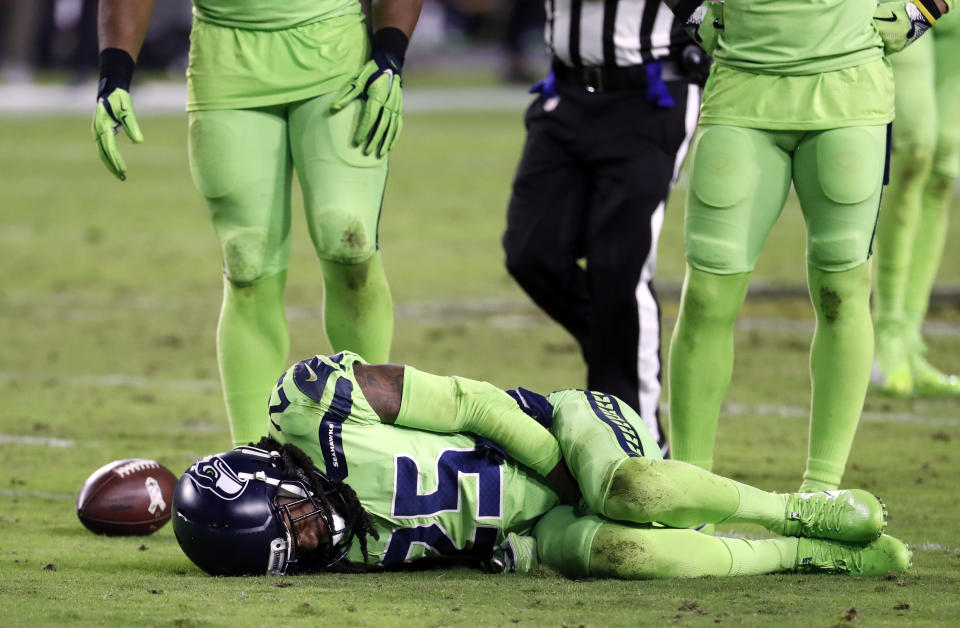NFL once again ignoring injury concerns with new 'Thursday Night Football' deal
BLOOMINGTON, Minn. – You probably heard that the NFL has a new $3.3 billion deal to broadcast “Thursday Night Football.” After all, big dollars make for big headlines.
You probably did not hear the latest injury data from the NFL, released last week. After all, medical information tends not to be as buzzworthy.
But it should be.

The injury rate (per game) on weekend and Monday games stayed roughly the same from 2016 to 2017. The Thursday rate jumped from 5.3 to 6.9.
The league held a conference call last week to discuss the data and the first speaker was Dr. Christina DeFilippo Mack, who is the senior director of epidemiology at clinical research company IQVIA. She said the following: “From 2014-17 … the rates of injuries occurring during Thursday games have not exceeded those suffered by players with more days of rest. This season, for the first time, we saw a one-year shift, where injury rates on Thursdays were slightly higher than games played on Saturday, Sunday, and Monday.”
[Stream Super Bowl LII live on the Yahoo Sports mobile app]
It’s “a one-year shift” so far. What if it becomes a two-year shift? Or three?
In fairness, Mack called it “not statistically significant.”
In his state of the league address at the Super Bowl, commissioner Roger Goodell said, “We don’t think it’s anything to overreact to.”
But it’s worrisome all the same. A lot of players do not like Thursday night games, and with good reason. They come off a difficult game on a Sunday, they sometimes have to travel that night, then they get only three days to heal, put in a new game plan for a new opponent, practice, and then it’s game day again. Richard Sherman, a noted opponent of Thursday football, said on a typical Wednesday a player is “still discovering bruises from Sunday that you didn’t know you had.”
Dr. Allen Sills, the NFL’s chief medical officer, was pressed on the “one-year shift” and he answered by asserting that “assessing the overall health and safety impact of the game is a lot more complex than just a simple injury rate.”
That’s fine, but then how are we supposed to know if “Thursday Night Football” is in fact more dangerous because of the short recovery time? Mack is measuring “any injury that caused the player to be removed from participation or precluded them from playing on a subsequent day,” but as we all know, NFL players fight through injuries without leaving the field of play. The 2014 data was a little different, as it was based on a “historical surveillance injury definition.” Then it was changed in 2015. The old bromide is “Are you hurt or are you injured?” Both should matter for this conversation.

Concussion symptoms, for example, do not always show up immediately after a head injury. Sometimes they appear the day after a game, or even a day after that. Having six or seven or even eight days to monitor a player – for a brain injury or any injury – has to be healthier than three.
And therein lies the dilemma. There’s no question that money helps the league and, indirectly, the players. A new TV deal and a new source of revenue lift all boats financially. But there’s also no question that more recovery time between games helps the league’s most valuable asset: the players themselves. It also helps the product on the field. How many unforgettable Thursday night games can you recall off-hand?
“I just don’t understand why the NFL says it’s taking a stand on player safety,” Sherman wrote in The Players Tribune, “then increases the risks its players face by making them play on Thursday, before their bodies are ready.”
It’s a good question with no good answer.
At this point, the NFL can have its $3.3 billion cake and eat it too. The money is rolling in, even though ratings have dipped slightly, and the injury data isn’t overwhelmingly negative. Yet.
But it’s fair to ask: if the injury rate for Thursdays develops into an alarming trend, what then? How many years of this would it take for the league to seriously consider scaling back Thursday night games?
Probably at least five, if not more. After all, money talks loudly, and injuries are usually kept to a whisper.
More from Yahoo Sports:
• MLB star was ‘inspired’ after Trump’s State of the Union
• S.C. coach blamed for fans spitting, using racial slurs
• In the Cousins sweepstakes, one team is an early favorite
• Timberlake urged to keep kids ‘safe’ during Super Bowl

